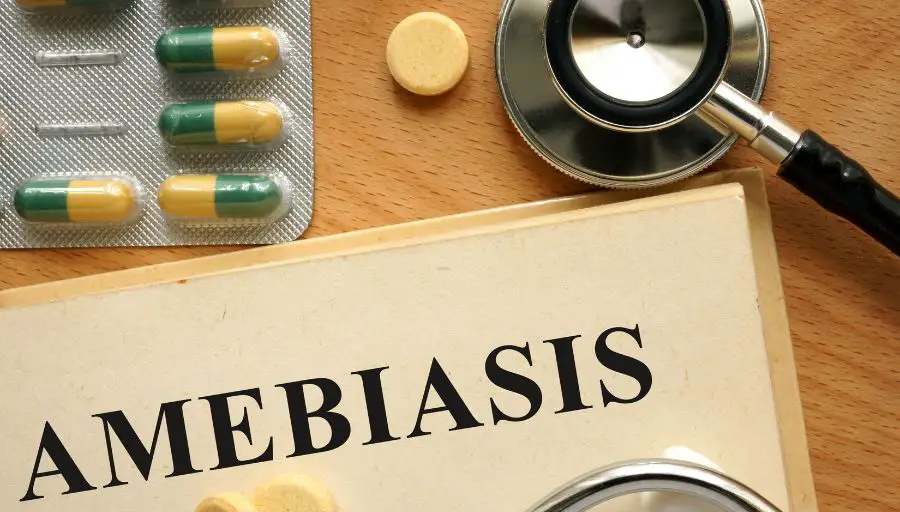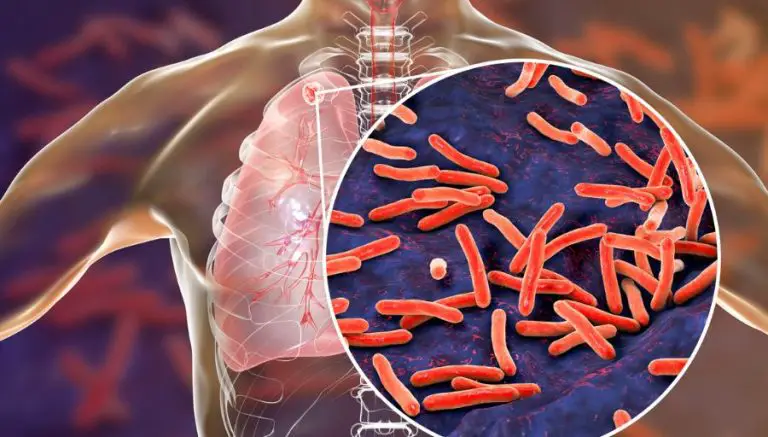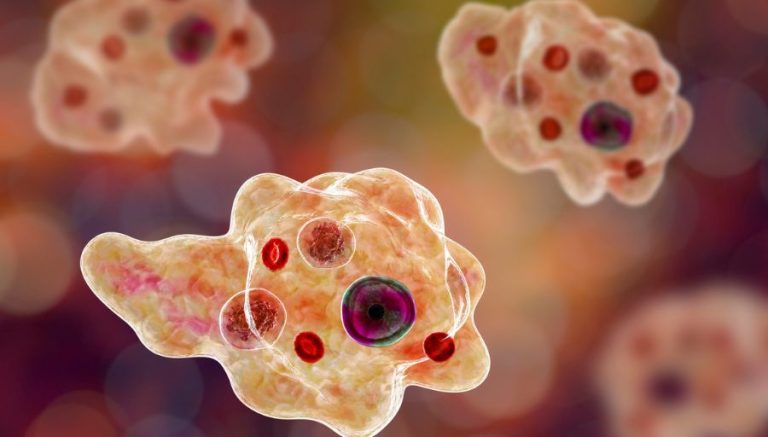A Comprehensive Guide to 8 Types of Amebiasis: Causes, Symptoms, Diagnosis, and Treatment
Eight common types of Amebiasis are discussed below. First will discuss Acute amebic dysentery, followed by Chronic intestinal Amebiasis, Amebic non-dysenteric colitis, Ameboma of intestine, Amebic liver abscess, Amebic lung abscess, Amebic brain abscess, and Cutaneous Amebiasis.
1. Acute amebic dysentery
The parasite Entamoeba histolytica, typically ingested with water and food contaminated by feces, causes acute amebic dysentery, an infection that affects the intestines.
Amebic dysentery is also known as Amebiasis, intestinal Amebiasis, amebic colitis, or diarrheal Amebiasis.
1.1 Symptoms
A patient with acute amebic dysentery can experience;
- severe watery diarrhea;
- abdominal cramps;
- fatigue;
- excessive gas formation;
- rectal pain with bowel movements; and
- weight loss.
The patient may have bloody stools, fever, vomiting, and abdominal tenderness in severe cases.
1.2 Diagnosis
Providers diagnose the condition based on the patient’s symptoms, history of overseas travel, and physical examination. Laboratory tests of the patient’s blood and feces can detect the organism.
1.3 Treatment
Treatment includes the use of antibiotics and rehydration with oral or intravenous fluids. Providers may educate patients who plan to travel to countries with poor sanitation to eat properly cooked vegetables and peeled fruit and drink boiled or purified water.
2. Chronic intestinal Amebiasis
The parasite Entamoeba histolytica, typically ingested with water and food contaminated by feces, causes chronic intestinal Amebiasis, an infection that affects the intestines.
Intestinal Amebiasis is also known as Amebiasis, amebic dysentery, amebic colitis, or diarrhea–Amebiasis.
2.1 Symptoms
A patient with chronic intestinal Amebiasis can experience;
- severe watery diarrhea;
- abdominal cramps;
- fatigue;
- excessive gas formation;
- rectal pain with bowel movements; and
- weight loss.
The patient may have bloody stools, fever, vomiting, and abdominal tenderness in severe cases.
2.2 Diagnosis
Providers diagnose the condition based on the patient’s symptoms, history of overseas travel, and physical examination. Laboratory tests of the patient’s blood and feces can detect the organism.
2.3 Treatment
Treatment includes the use of antibiotics and rehydration with oral or intravenous fluids. Providers may educate patients who plan to travel to countries with poor sanitation to eat properly cooked vegetables and peeled fruit and drink boiled or purified water.
3. Amebic non-dysenteric colitis
The parasite Entamoeba histolytica, typically ingested with water and food contaminated by feces, causes amebic nondysenteric colitis, an infection that affects the intestines.
3.1 Symptoms
A patient with amebic non-dysenteric colitis can experience;
- fatigue;
- excessive gas formation; and weight loss.
In severe cases, the patient may have fever, vomiting, and abdominal tenderness.
3.2 Diagnosis
Providers diagnose the condition based on the patient’s symptoms, history of overseas travel, and physical examination. Laboratory tests of the patient’s blood and feces can detect the organism.
3.3 Treatment
Treatment includes the use of antibiotics. Providers may educate patients who plan to travel to countries with poor sanitation to eat properly cooked vegetables and peeled fruit and drink boiled or purified water.
4. Ameboma of intestine
Ameboma of the intestines is a carcinoma–like lesion or mass of granulation tissue, a rare complication of Amebiasis or infection of the intestines caused by Entamoeba histolytica.
4.1 Symptoms
A patient with ameboma of the intestine can experience;
- bloody diarrhea;
- abdominal pain; and
- fever.
4.2 Diagnosis
Providers diagnose the condition based on the patient’s symptoms, history of overseas travel, and physical examination.
4.3 Treatment
Laboratory tests of the patient’s blood and feces can detect the organism. The provider may perform a colonoscopy. Treatment includes antibiotics, oral or intravenous fluid rehydration, and/or surgical treatment.
5. Amebic liver abscess
The parasite Entamoeba histolytica, typically ingested with water and food contaminated by feces, causes amebic liver abscess, a collection of pus in the liver.
5.1 Symptoms
A patient with an amebic liver abscess can experience;
- abdominal pain;
- fever;
- chills;
- fatigue;
- cough;
- diarrhea;
- sweating;
- loss of appetite;
- weight loss; and
- jaundice.
5.2 Diagnosis
Providers diagnose the condition based on the patient’s symptoms and radiological scans such as abdominal ultrasound, CT, MRI, and liver scans. Laboratory tests of the patient’s blood and feces can detect the organism.
5.3 Treatment
Treatment includes using antibiotics, rehydration with oral or intravenous fluids, drainage of the abscess, and/or surgical treatment.
6. Amebic lung abscess
Amebic lung abscess is a collection of pus in the lung, a rare complication of Amebiasis caused by Entamoeba histolytica.
6.1 Symptoms
A patient with amebic lung abscess can experience;
- abdominal pain;
- fever and chills;
- fatigue;
- cough;
- diarrhea;
- sweating;
- loss of appetite; and
- weight loss.
6.2 Diagnosis
Providers diagnose the condition based on the patient’s symptoms and radiological scans such as X–ray of lung, abdominal ultrasound, CT scan, or MRI, and lung scan. Laboratory tests of the patient’s blood and feces can detect the organism.
6.3 Treatment
Treatment includes using antibiotics, rehydration with oral or intravenous fluids, drainage of the abscess, and/or surgical treatment.
7. Amebic brain abscess
Amebic brain abscess is a collection of pus in the brain, a rare complication of Amebiasis caused by Entamoeba histolytica.
7.1 Symptoms
A patient with an amebic brain abscess can experience the following;
- headaches;
- confusion;
- neck stiffness;
- fever;
- chills;
- weakness;
- one–sided muscle control loss;
- decreased sensation; and
- diminished vision.
7.2 Diagnosis
Providers diagnose the condition based on the patient’s symptoms, radiological scans such as a CT or MRI of the head, and electroencephalogram (EEG). Laboratory tests of the patient’s blood and feces can detect the organism.
7.3 Treatment
Treatment includes antibiotics, drainage of the abscess, and/or surgical treatment.
8. Cutaneous Amebiasis
The parasite Entamoeba histolytica, typically ingested with water and food contaminated by feces, causes cutaneous Amebiasis, a rare condition that causes damage to the skin and underlying soft tissues.
8.1 Symptoms
A patient with cutaneous Amebiasis can experience;
- irregular, necrotic, or oval skin ulcers;
- cutaneous lesions on buttocks, trunk, perineum, genitalia, and legs; and
- subcutaneous swelling.
8.2 Diagnosis
Providers diagnose the condition based on the patient’s symptoms, history of overseas travel, and physical examination. Laboratory tests of the patient’s blood, feces, and skin biopsy can detect the organism.
8.3 Treatment
Treatment includes the use of antibiotics and/or surgical treatment.







